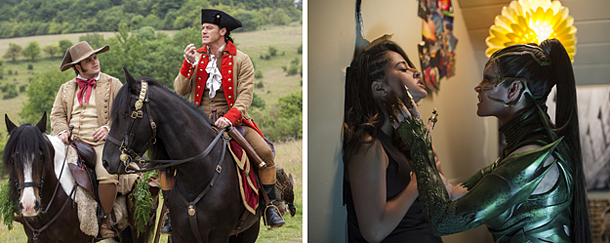‘Gay moments’ in film: Progress or insignificant?

Left: Josh Gad, left, and Luke Evans appear in a scene from, “Beauty and the Beast.” Right: Becky G portrays Trini, the Yellow Ranger, left, and Elizabeth Banks portrays Rita Repulsa in a scene from “Power Rangers.” [AP/YONHAP]
From Sulu in “Star Trek Beyond’’ to LeFou in “Beauty and the Beast’’ and now Trini in “Power Rangers,’’ the latest Hollywood fascination is the subtle nod that a once straight or undefined character is now or has always been gay.
But it’s often so subtle that if it wasn’t first discussed by filmmakers or actors, it’s a wonder whether anyone would notice at all. Sulu can be seen hugging a man. LeFou winks at Gaston and later dances with a man. And Trini fails to answer a flirty question about whether she’s having “boyfriend problems’’... or “girlfriend problems?’’
What are we to make of these “blink and you’ll miss them’’ moments in a year when “Moonlight,’’ with its explicit exploration of gay themes, can rise to become the best picture winner at the Academy Awards? Is this progress? For some, it is. For others, it’s too much acclaim for too little action.
Buzzfeed film critic Alison Willmore wrote an article on Wednesday exploring the “outsized credit’’ that Hollywood is getting for the recent “seriously small moments of LGBT inclusivity.’’
“While, to be sure, even incremental progress should be celebrated-- any forward movement is better than none -- this is an incredibly unsatisfactory beat to go on to be widely disseminated as a breakthrough for inclusivity,’’ Willmore wrote of the ambiguous “Power Rangers’’ moment.
Not so ambiguous is how the film industry is lagging in LGBT representation, especially compared with strides that have been made in television. A 2016 report by the University of Southern California found that 82 of the 100 top movies of 2015 did not depict one LGBT speaking or named character. In a study by the gay advocacy group GLAAD of major studio releases in 2015, 17.5 percent contained characters identified as lesbian, gay, bisexual, or transgender-- a percentage that was unchanged from 2014.
But even “Beauty and the Beast’’ director Bill Condon and many of his cast quickly retreated from previous comments about the film’s “gay moment,’’ saying the response had been “overblown.’’
Hollywood might not be to blame for the dozens of articles that help to amplify small moments that are also socially significant firsts (“first gay superhero’’ and “first gay Disney character’’). They’re eminently clickable and part of the modern business model of internet news, especially as the public, actors and filmmakers weigh in.
For GLAAD President and CEO Sarah Kate Ellis, however, the minor moments are ``incredibly important,’’ especially in major studio films with significant youth audiences. A film like “Moonlight,’’ she noted, is an adult film that came out from an independent distributor and producer.
“LGBT youth have a right to see their happily ever after, too,’’ Ellis said.
Ellis knows the “moments’’ are just a first step -- she would like to eventually see LGBT protagonists in all-ages films -- but for her, it shows that major studios, often too risk averse to change, are making an effort to test the waters.
AP










with the Korea JoongAng Daily
To write comments, please log in to one of the accounts.
Standards Board Policy (0/250자)